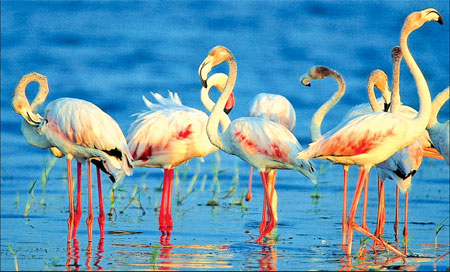|
 The Kumana National Park is a well-known bird sanctuary, where a
multitude of birds breed and roost. One of the most significant features
of the park is the Kumana Villu - a 200 hectare natural swamp lake, fed
by the Kumbukkan Oya through a half mile long narrow channel. It is at
this mangrove swamp that many water birds nest in May and June. The Kumana National Park is a well-known bird sanctuary, where a
multitude of birds breed and roost. One of the most significant features
of the park is the Kumana Villu - a 200 hectare natural swamp lake, fed
by the Kumbukkan Oya through a half mile long narrow channel. It is at
this mangrove swamp that many water birds nest in May and June.
Regular sightings include pelicans, painted storks, spoonbills, white
ibis, herons, egrets and little cormorants. The rare black-necked stork
has also been spotted at the swamp. Besides the prolific birdlife,
Kumana is also home to some of the mammals found in the larger Yala
(West) park, such as elephants and leopards.
The vegetation in Kumana consists mainly of mangrove trees, kumbuk
trees and the karan fern, as well as the open marsh area. It is also
known as the Yala East National Park is in the Ampara district of
south-east of Sri Lanka at a distance of 391 kilometres from Colombo.
The gateway to Kumana National Park is at Panama. The park office is
at Okanda, 22km south of Panama. Kumuna receives 1,300 millimetres
(51.18 in) of annual rainfall. The mean annual temperature is 27 degrees
Celsius.
The Park spreads over 35,664 hectares. In the west, the park is
bordered by the Kumubukkan Oya; to the south is south-eastern coast that
runs to Panama. The Kumana Villu is subject to occasional inundation
with sea water. It is at this swamp that many water birds nest, during
the months of May and June. Scattered in the Kumana National Park are
several water pools that are favourite spots of the wildlife: Kudawila
wewa, Thummulla wewa and Kotalinda wewa. Kumana National Park provides
excellent feeding and resting habitats for a large number of threatened
wetland species, including three turtle species such as the Green Turtle
(Chelonia mydas), Loggerhead Turtle (Caretta caretta), and the Olive
Ridley Turtle (Lepidochelys olivaceae).
Among other threatened species of reptiles are the globally
vulnerable Mugger Crocodile (Crocodylus palustris).The most sighted
reptiles at the Kumana National Park are Mugger Crocodile, the Indian
Flap-shelled Turtle, and the Indian Black Turtle.
Birdlife

Sri Lanka records more than 430 bird species comprising endemic,
resident and migrant birds. Of these, the bird watchers are able to
watch over 200 species easily. The wide variety of birds found in the
numerous wildlife parks of Sri Lanka makes the tropical island a prime
bird watching destination in the world.
The Kumana National Park is the most important and most popular bird
sanctuary in Sri Lanka. Kumana birdlife supported by Some 20 lagoons and
tanks is an ornithologist's paradise. During April and July, tens of
thousands of birds migrate to the Kumana swamp area. Annually nearly 255
species of birds have been recorded in the National Park.
- Internet |


